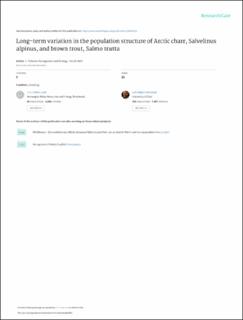| dc.description.abstract | The effects of induced water level fluctuations and introduction of the mysid Mysis relicta Lovén on population structure of brown trout, Salmo trutta L., and Arctic charr, Salvelinus alpinus (L.), were studied during 1953–1995 in Limingen hydroelectric reservoir, Norway. The main response was a marked reduction in catch-per-unit-effort (CPUE) for trout and charr, probably caused by reduced recruitment following increased variation in water level. For both species, mean length decreased until 1967 and increased thereafter, whereas mean mass-at-length increased for the whole period. Both length and mass-at-length were negatively correlated with CPUE. The increases in mean length and mass-at-length were probably because of reduced competition following the reduced recruitment. Mysis relicta has become an important food item for charr but not for brown trout, but the increases in mean length and mass-at-length of charr started prior to the appearance of M. relicta in the charr diet. | en_US |
